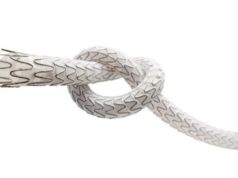 PQ Bypass has announced CE mark approval for a trio of proprietary devices: the Torus stent graft system, PQ Snare, and PQ Crossing Device, which enables physicians to perform a fully percutaneous femoropopliteal bypass in patients with TASC II C and D lesions in the superficial femoral artery due to peripheral artery disease (PAD).
PQ Bypass has announced CE mark approval for a trio of proprietary devices: the Torus stent graft system, PQ Snare, and PQ Crossing Device, which enables physicians to perform a fully percutaneous femoropopliteal bypass in patients with TASC II C and D lesions in the superficial femoral artery due to peripheral artery disease (PAD).
Historically, extremely long peripheral artery blockages were treated by open bypass surgery, with the field now increasingly moving to endovascular solutions. While standard endovascular approaches decrease procedure morbidity associated with surgery, they have not yet demonstrated the durability of open bypass surgery. The Detour procedure, says PQ Bypass, “is designed to match or exceed the durable patency associated with open surgical bypass, but achieve those results with a minimally invasive endovascular procedure that allows rapid return to full function.”
The Torus stent graft system is an expanded polytetrafluoroethylene (ePTFE) covered self-expanding nitinol stent intended to improve blood flow in patients with symptomatic peripheral artery disease in superficial femoral artery de novo and restenotic TASC II C and D lesions. The PQ Snare and PQ Crossing Devices are intended for the retrieval and manipulation of atraumatic foreign bodies in the distal peripheral vasculature and to support the placement and positioning of guidewires in the peripheral vasculature, respectively.
“There is a great unmet need for a durable percutaneous option for these patients with extremely long blockages in the legs due to PAD,” says Sean Lyden, chairman of the Robert and Suzanne Tomsich Department of Vascular Surgery at Cleveland Clinic’s Sydell and Arnold Miller Family Heart & Vascular Institute, Cleveland, USA. “While other percutaneous approaches have been attempted, long-term success and patency have been difficult to achieve, resulting in limited options for these patients.”
The CE mark approval was based on data collected in DETOUR I, a prospective, multicentre, core-lab reviewed single-arm trial designed to evaluate the safety and efficacy of the Detour procedure in patients with TASC II C and D total occlusions in the femoropopliteal anatomy. The six-month results from DETOUR I, which were presented in January at the Leipzig Interventional Course (LINC 2017), met both primary safety and effectiveness endpoints.
“The Detour procedure is a truly new and innovative approach to treating patients with extremely long SFA lesions,” said Dainis Krievins, professor of vascular surgery, University of Latvia, Director, Institute of Research of Pauls Stradins Clinical University Hospital, Riga, Latvia, and investigator in the DETOUR I study. “The initial safety and effectiveness of the Detour procedure, as shown in the DETOUR I trial, is very encouraging and the results clearly demonstrate the potential for this to become a key addition to the treatment armamentarium for patients with complex PAD.”
The Detour procedure is a fully-percutaneous femoropopliteal bypass procedure. Using fluoroscopic guidance, a series of proprietary Torus stent grafts are deployed from the popliteal artery into the femoral vein, and from the femoral vein into the superficial femoral artery in a continuous, overlapping fashion through two independent anastomoses. The final result is a large lumen, endograft bypass that delivers unobstructed, pulsatile flow from the SFA ostium to the popliteal artery, restoring blood flow to the lower extremities.
“With an increased focus on value-based and patient-centred medicine, surgical advancements that minimise trauma to patients, reduce length of hospital stay and recovery times are critical global needs,” said Peter Wehrly, president and chief executive officer of PQ Bypass. “CE mark is an important milestone for PQ Bypass and we look forward to continuing our clinical studies, including an upcoming IDE study, with an eye toward FDA approval. Data presented at LINC 2017 demonstrated that the Detour procedure has clear potential as a viable change in how extremely long SFA occlusive disease is treated in the future.”













